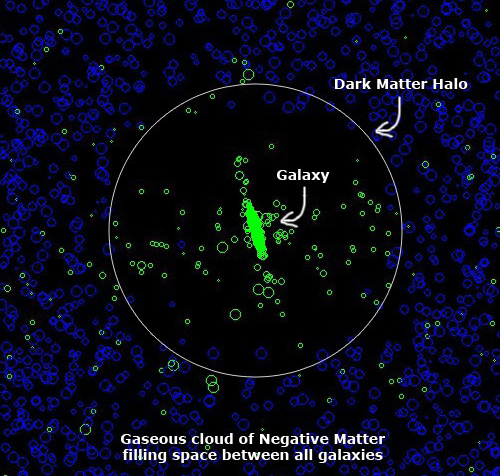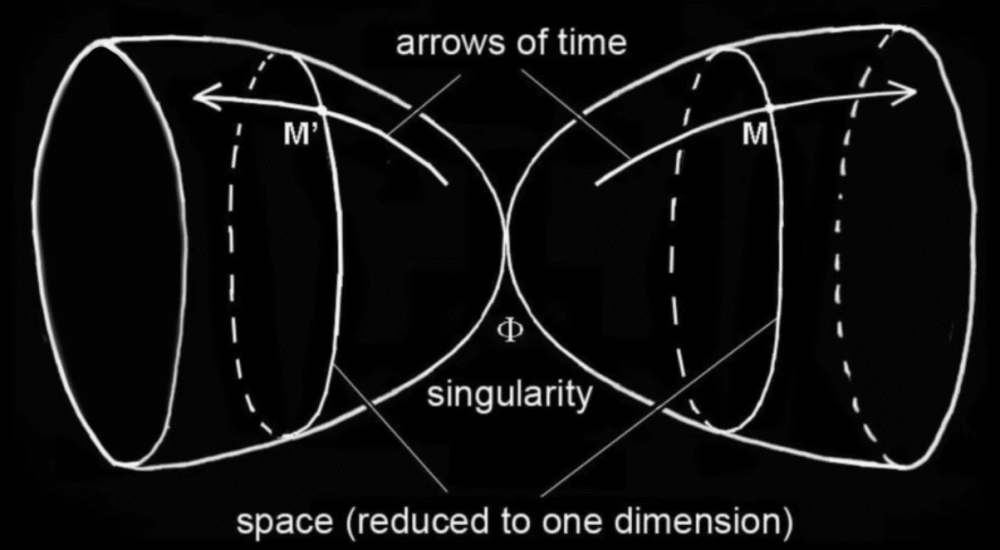Negative Mass and the Anti-Universe 2025-11-06
Our dark matter detectors have still failed to find anything, indicating that dark matter requires some form of new physics in order to be understood. Both WIMP's and MOND fail to account for many recent observations and they don't hold up to real scrutiny. Adding to the problem, we still don't have a good explanation for dark energy, and recent studies have found that the density of dark energy seems to be dropping over time, overturning the long held idea of a "cosmological constant".
In 2018 I made a video covering an alternative approach which has the potential to solve both the dark matter and dark energy problems. At around the 44 minute mark of the video I predicted that the density of dark energy should appear to decrease over time. The model I'm referring to was first developed in the 70's, it has been called the Anti-Universe, Twin Universe, and Hourglass Universe model. Despite the power of the model, it has been mostly ignored by mainstream science.
Admittedly, there are some issues with the model which I will discuss in this article, but I would argue WIMP and MOND models have many more issues. I do understand why this model has been neglected, but I also think this model is simpler and more powerful than the most popular models, allow me to explain. In order for energy to be conserved during the birth of our universe, we assume an equal amount of negative and positive energy was involved, resulting in a "zero-energy universe".
Some researches believe the anti-universe could contain anti-matter, explaining the reason we see barely any anti-matter in our universe. Objects in the anti-universe would experience negative time since reversing the energy/mass of a particle would reverse its arrow of time. Even Hawking believed we live in a zero-energy universe, but he believed the negative energy exists as gravitational potential energy. It's still not clear what form negative energy might take or if it even exists.
However, if we use a literal interpretation of the mass-energy equivalence principle, and assume some form of negative mass must exist, then some form of negative matter must also exist. The negative matter would have negative gravity (anti-gravity) and be repelled away from large clumps of positive matter such as galaxies, making it very hard to detect. Unlike normal matter, which clumps together due to gravity, the negative matter would remain in a gaseous state filling space between galaxies.
It was once believed that gravity would pull everything together, causing the universe to end in a "Big Crunch". The cloud of negative matter would have the opposite effect, it would push all the galaxies apart and cause the expansion we observe (assuming an infinite flat universe). In other words, a cloud of negative matter would behave just like dark energy. The negative matter would also get diluted over time, explaining why the density of dark energy appears to be falling.
It also explains why the universe appears to be so isotropic and homogeneous, along with many other big problems in physics. If the negative matter is repelled from galaxies, it would create a spherical cavity around the galaxy, and this could explain the true nature of the dark halo. It's not some invisible particle, it's a lack of negative mass particles around the galaxy. Since taking away negative mass is equivalent to adding positive mass, it creates the illusion of invisible mass.

This explains the overly intense gravitational lensing we see when we observe distant galaxies. It also helps explain the flat rotation curves we measure when observing galaxies, because as an object moves closer to the edge of the halo, it experiences an increasingly stronger force trying to push it back towards the core of the galaxy due to all the negative mass surrounding the galaxy. Or thinking about it another way, we can substitute the halo cavity for an equivalent amount of positive mass.
In that case we can apply the Shell Theorem, and treat it like a spherically symmetrical body, since the density of the cavity doesn't change much. So as an object moves away from a galaxy, the force of gravity pulling the object back towards the galactic core will increase due to the halo of positive mass surrounding the galaxy. The main reason we believe dark matter must exist is because most galaxies are rotating so fast they would shoot apart without it.
This model replicates the same forces as dark matter, allowing us to explain the overly flat rotation curves we measure on most galaxies. It explains how galaxies are able to hold themselves together and also explains the overly intense lensing effects we see around galaxies. Furthermore, it explains the true nature of dark energy, and solves many other big problems in Cosmology such as the "Cuspy Halo Problem" and "Dwarf Galaxy Problem".
It achieves all of that without any ad-hoc mechanisms, the model emerges very organically from our initial assumptions about energy conservation and the mass-energy equivalence principle. However, there are some issues with the model, as I mentioned. Negative mass has never been detected, and our recent experiments to test the gravity of anti-matter seem to confirm that anti-matter falls down towards Earth just like normal matter, suggesting anti-matter may not be a form of negative matter.
Having said that, if we use some basic Newtonian mechanics to model the behavior of negative matter, a small negative particle would be attracted to a large positive mass. A positive mass particle would be repelled from a negative mass particle, but the negative mass particle would also be attracted to the positive mass particle. This can result in hypothetical scenarios where a positive and negative particle become aligned and produce "runway motion", accelerating without limit.
Due to the lack of evidence, and the strange gravitational properties that negative mass is expected to have, most scientists don't think negative mass/matter can exist. Runaway motion would be strange, but my particle simulations have shown that it never actually occurs since it's virtually impossible for two particles to become perfectly aligned, and even if they do manage it, external forces will quickly cause their trajectories to become unaligned.
Also, runaway motion only occurs when we use Newtonian mechanics to determine how negative mass behaves. If we instead use a bimetric model of relativity, where the universe is described as a manifold associated to two Riemannian metrics (one with positive mass and the other with negative mass), we find that runaway motion cannot occur because negative and positive mass both repel each other. However, we also find that negative masses would be attracted to other negative masses.
That presents a problem because we want the negative matter to remain in a gas state so that we can explain dark energy and dark matter. It also seems unlikely that astronomers would overlook the existence of large negative masses floating around the universe if they did exist. On the other hand, objects such as the dipole repeller could suggest that large clusters of negative mass do exist, and that could help explain the large voids in the universe and galaxy filament structures.
Figure from A bimetric cosmological model based on Andreï Sakharov’s twin universe approach showing formation of large scale galactic structures, with "immense negative-mass protostars" in the center of the voids.
One potential solution to prevent the negative matter from clumping together is to model it as a type of fluid or super-fluid, a relatively new idea referred to as "dark fluid" theory. It's worth noting the dark fluid model is unrelated to the twin universe models and uses different mechanisms to explain dark matter and dark energy. Personally, I'm not sure about treating negative mass as a fluid, I prefer bimetric models such as the Janus model.
The Janus model embraces the concept of negative matter collapsing into large objects, because it avoids runaway motion and explains large scale structures, but if the negative mass doesn't remain in a fluid or gas state, then it's unclear to me how dark matter can be explained unless there actually is a dark matter particle. There are many reasons to believe dark matter is some sort of gravitational illusion and not a particle, that's why I like the cavity model.
Modeling the dark halo as a cavity of negative matter around galaxies to create the illusion of invisible positive mass solves many mysteries such as the Cuspy Halo Problem. Bimetric models suggest that negative mass is isolated to a parallel universe, and that anti-universe can only interact with our universe through the force of gravity. This is a great explanation for why we can't detect any dark matter but we can clearly see the gravitational effects of it.
Several years ago I did some crude calculations to estimate the ratio of positive mass to negative mass in our observable universe and I found that our universe needs to be at least 90% negative mass/energy. This is primarily caused by the fact there's such a large volume of space in between all the galaxies, the density of negative matter needs to be very high in order for a cavity within it to have a sufficient impact on the curvature of space-time.
Scientists believe only 5% of the universe consists of ordinary matter, the rest is dark matter and dark energy. The Janus model predicts the universe is made from 95% negative mass by removing the unnecessary dark matter component.
It's reasonable to assume different parts of the universe could have a different ratio of positive to negative energy, simply due to random variations in the early universe, perhaps corresponding to the CMB, but I wasn't expecting the ratio for our local universe to be over 90% negative energy. That feels like it's starting to approach the realm of fine-tuning in order to make the model work and it undermines our initial assumptions about energy conservation.
I'm not a cosmologist so there's a good chance I'm overlooking something important or I'm getting something wrong, but as time goes on I'm becoming increasingly convinced this model or some variant of it is on the right track. The model emerges from simple and intuitive logic and manages to overcome many of the pitfalls found in WIMP and MOND models. It solves so many big problems in elegant ways, extending the theory of general relativity rather than challenging it.
I feel this model really deserves more research because it touches upon so many different areas of physics and provides a solution to multiple big problems in cosmology. Comparing the behavior of dark matter and dark energy to the behavior predicted by this model is important, but the best way to validate or falsify this model will probably be to look at the large scale structure of the universe and compare it to the cellular structures predicted by this model.

